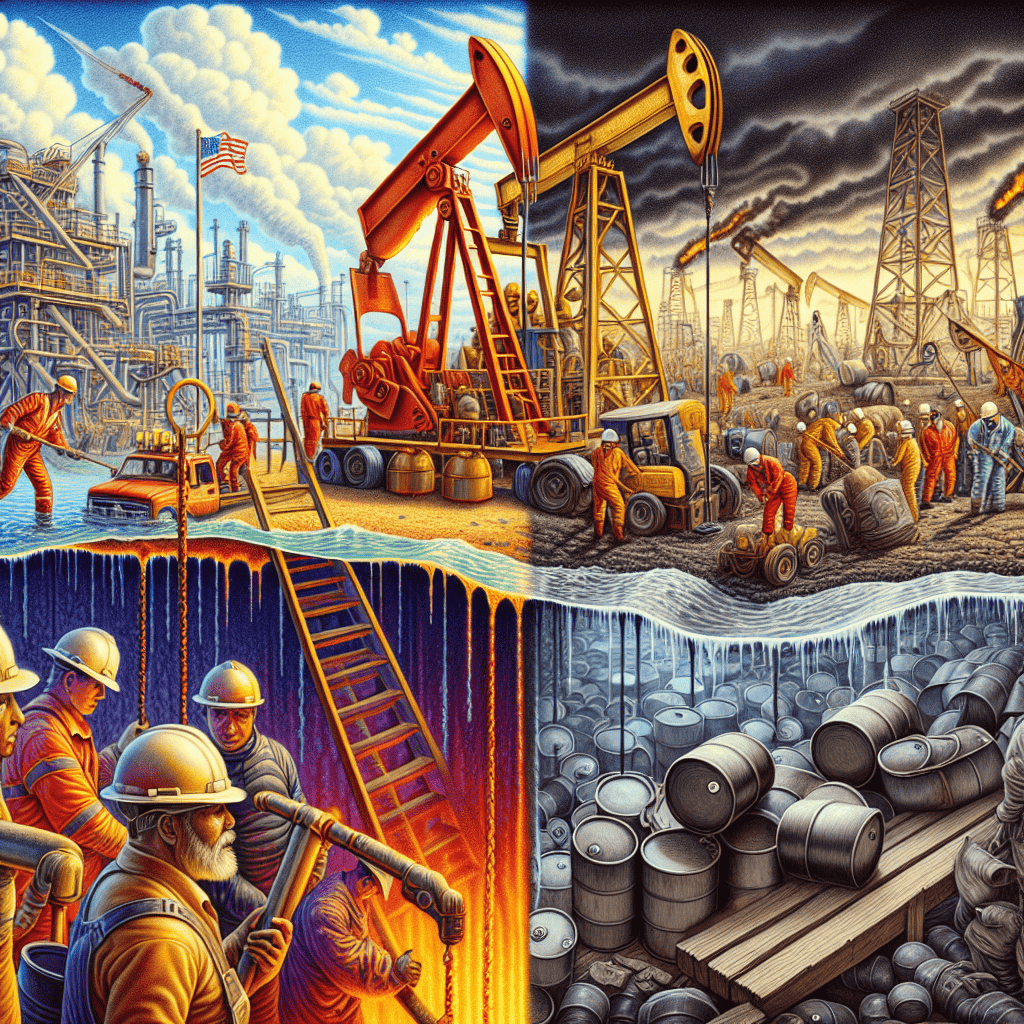“Fueling Prosperity Today, Preparing for Tomorrow’s Challenges.”
Introduction
“Thriving in America’s Oil Boom While Bracing for the Bust” explores the dynamic landscape of the U.S. oil industry, characterized by periods of rapid growth and inevitable downturns. This narrative delves into the strategies and resilience required by businesses, communities, and individuals to capitalize on the economic opportunities presented by oil booms while preparing for the challenges of subsequent busts. It examines the economic, social, and environmental impacts of these cycles, offering insights into sustainable practices and adaptive measures that can mitigate the adverse effects of volatility in the oil market. Through a blend of case studies and expert analysis, the introduction sets the stage for understanding how stakeholders can navigate the complexities of thriving in a fluctuating industry.
Navigating Economic Cycles: Strategies for Oil Industry Professionals
The oil industry has long been a cornerstone of the American economy, driving growth and innovation while also presenting unique challenges due to its cyclical nature. As the United States experiences another oil boom, industry professionals find themselves in a position to capitalize on opportunities while simultaneously preparing for the inevitable downturn. Understanding the dynamics of these economic cycles is crucial for those seeking to thrive in this volatile sector.
To begin with, the current oil boom is largely driven by technological advancements in extraction methods, such as hydraulic fracturing and horizontal drilling. These innovations have unlocked vast reserves of oil and natural gas, particularly in shale formations, leading to a surge in production. Consequently, the United States has emerged as a leading global oil producer, reshaping energy markets and reducing dependency on foreign oil. For industry professionals, this boom presents a wealth of opportunities, from increased employment prospects to lucrative investment ventures.
However, history has shown that what goes up must eventually come down. The oil industry is notorious for its boom-and-bust cycles, driven by fluctuating global demand, geopolitical tensions, and market speculation. As such, professionals in the field must adopt strategies to navigate these cycles effectively. One key approach is diversification. By expanding their skill sets and exploring opportunities in related sectors, such as renewable energy or petrochemicals, industry workers can mitigate the risks associated with a downturn in oil prices. This not only enhances job security but also positions them to take advantage of emerging trends in the energy landscape.
Moreover, financial prudence is essential during boom periods. While the temptation to capitalize on high salaries and bonuses is strong, it is wise to save and invest wisely to cushion against future uncertainties. Building a robust financial safety net can provide stability during lean times, allowing professionals to weather the storm without significant lifestyle disruptions. Additionally, companies can adopt similar strategies by maintaining healthy balance sheets and avoiding over-leveraging during periods of high profitability.
Furthermore, continuous learning and adaptation are vital in an industry characterized by rapid technological advancements and shifting regulatory landscapes. Professionals who stay abreast of the latest developments and acquire new skills are better equipped to remain competitive and relevant. This might involve pursuing further education, attending industry conferences, or engaging in professional networks to exchange knowledge and insights. By fostering a culture of lifelong learning, individuals and organizations can enhance their resilience and adaptability in the face of economic fluctuations.
In addition to individual strategies, collaboration and communication within the industry are paramount. By fostering partnerships and sharing best practices, companies can collectively address challenges and seize opportunities. This collaborative approach can lead to more efficient operations, reduced costs, and innovative solutions that benefit the entire sector. Moreover, engaging with policymakers and stakeholders can help shape favorable regulatory environments that support sustainable growth and stability.
In conclusion, while the current oil boom offers significant opportunities for industry professionals, it is imperative to remain vigilant and prepared for the eventual downturn. By embracing diversification, financial prudence, continuous learning, and collaboration, individuals and organizations can navigate the cyclical nature of the oil industry with confidence. As the sector continues to evolve, those who adopt these strategies will be well-positioned to thrive, regardless of the economic climate.
Diversifying Investments: Preparing for the Oil Market Downturn
The recent surge in America’s oil production has brought about a period of economic prosperity, particularly in regions rich in oil reserves. This boom has not only bolstered local economies but also contributed significantly to the national GDP. However, history has shown that the oil market is inherently volatile, with periods of rapid growth often followed by sharp downturns. Consequently, it is imperative for investors and stakeholders to consider diversifying their investments to mitigate the risks associated with a potential market bust.
To begin with, the oil industry is subject to a myriad of factors that can influence its stability, including geopolitical tensions, regulatory changes, and fluctuations in global demand. These elements can lead to unpredictable price swings, making it crucial for investors to adopt a proactive approach in safeguarding their portfolios. Diversification, in this context, serves as a strategic tool to spread risk across various asset classes, thereby reducing the impact of adverse market conditions on one’s financial standing.
One effective strategy for diversification is to invest in renewable energy sources. As the world increasingly shifts towards sustainable energy solutions, the demand for renewables such as solar, wind, and hydroelectric power is expected to rise. By allocating a portion of their investments to these sectors, investors can capitalize on the growing trend towards clean energy while simultaneously hedging against the volatility of the oil market. Moreover, government incentives and technological advancements in renewable energy further enhance the attractiveness of this investment avenue.
In addition to renewables, investors might consider exploring opportunities in technology and innovation. The tech industry has consistently demonstrated resilience and growth potential, driven by continuous advancements and the ever-increasing reliance on digital solutions. By investing in technology companies, particularly those involved in energy efficiency and smart grid technologies, investors can benefit from the synergies between tech and energy sectors. This not only provides a buffer against oil market fluctuations but also aligns with the broader global movement towards energy efficiency and sustainability.
Furthermore, real estate presents another viable option for diversification. The real estate market, while not immune to economic cycles, often exhibits different patterns of growth and decline compared to the oil industry. Investing in properties, especially in areas experiencing economic growth due to the oil boom, can offer steady income streams and potential appreciation in value. Additionally, real estate investments can serve as a tangible asset that provides a sense of security amidst the uncertainties of the oil market.
It is also worth considering the role of financial instruments such as bonds and mutual funds in a diversified investment strategy. Bonds, particularly those issued by stable governments or corporations, can offer fixed returns and lower risk compared to equities. Mutual funds, on the other hand, provide access to a diversified portfolio managed by financial experts, allowing investors to benefit from professional insights and risk management strategies.
In conclusion, while the current oil boom presents lucrative opportunities, it is essential for investors to remain vigilant and prepare for the inevitable market downturn. By diversifying their investments across renewable energy, technology, real estate, and financial instruments, investors can not only protect their portfolios from the volatility of the oil market but also position themselves for long-term growth and stability. As the adage goes, it is wise not to put all one’s eggs in one basket, especially in an industry as unpredictable as oil.
Community Resilience: Supporting Local Economies in Oil-Rich Regions
The recent surge in oil production across the United States has brought significant economic benefits to many local communities, particularly in regions rich in oil reserves. This boom has led to increased employment opportunities, higher wages, and a boost in local businesses, creating a ripple effect that has invigorated these areas. However, while the immediate economic advantages are undeniable, the cyclical nature of the oil industry necessitates a strategic approach to ensure long-term community resilience. As history has shown, the volatility of oil prices can lead to sudden downturns, leaving communities vulnerable if they are overly reliant on this single industry.
To thrive during the oil boom while preparing for potential busts, communities must focus on diversifying their local economies. This involves investing in sectors that can provide stability and growth even when oil prices fluctuate. For instance, developing renewable energy projects can offer a sustainable alternative, creating jobs and reducing dependency on oil. Additionally, supporting local entrepreneurship and small businesses can foster a more resilient economic environment. By encouraging innovation and providing resources for startups, communities can cultivate a diverse economic landscape that is less susceptible to the whims of the oil market.
Education and workforce development are also crucial components in building community resilience. By investing in education and training programs, communities can equip their residents with the skills needed to adapt to changing economic conditions. This not only enhances individual employability but also attracts a broader range of industries to the area. For example, partnerships between local educational institutions and businesses can create tailored programs that address specific workforce needs, ensuring that the local labor market remains competitive and versatile.
Moreover, prudent fiscal management by local governments plays a vital role in preparing for economic downturns. During periods of prosperity, it is essential for these governments to build financial reserves and invest in infrastructure that can support long-term growth. This might include improving transportation networks, expanding broadband access, or enhancing public services, all of which can make a community more attractive to diverse industries. By maintaining a strong financial foundation, local governments can better weather economic challenges and continue to provide essential services to their residents.
Community engagement and collaboration are equally important in fostering resilience. By involving residents in decision-making processes and encouraging public-private partnerships, communities can develop strategies that reflect the needs and aspirations of their members. This collaborative approach not only strengthens social cohesion but also ensures that economic development initiatives are inclusive and equitable. Engaged communities are better positioned to identify opportunities and challenges, allowing them to respond proactively to changes in the economic landscape.
In conclusion, while the oil boom presents significant opportunities for economic growth, it is imperative for communities in oil-rich regions to adopt a forward-thinking approach to ensure their long-term resilience. By diversifying their economies, investing in education and workforce development, practicing sound fiscal management, and fostering community engagement, these areas can build a robust foundation that supports sustainable growth. As they navigate the complexities of the oil industry, these strategies will enable them to not only thrive during periods of prosperity but also remain resilient in the face of inevitable downturns. Through careful planning and collaboration, communities can secure a prosperous future that benefits all residents, regardless of the fluctuations in the oil market.
Sustainable Practices: Balancing Profit and Environmental Responsibility

The recent surge in America’s oil production has brought about significant economic benefits, yet it also presents a complex challenge: balancing the pursuit of profit with the imperative of environmental responsibility. As the nation experiences an oil boom, driven by advancements in extraction technologies such as hydraulic fracturing and horizontal drilling, the economic landscape is being reshaped. This boom has led to increased job creation, energy independence, and substantial contributions to the national economy. However, the environmental implications of such rapid development cannot be overlooked, necessitating a strategic approach to ensure sustainability.
To thrive in this booming industry while preparing for the inevitable bust, companies must adopt sustainable practices that align with both economic and environmental goals. One of the primary strategies involves investing in technology that minimizes environmental impact. For instance, the implementation of advanced water management systems can significantly reduce the consumption and contamination of water resources, a critical concern in hydraulic fracturing operations. By recycling and reusing water, companies not only conserve a vital resource but also reduce operational costs, thereby enhancing profitability.
Moreover, the integration of renewable energy sources into oil extraction processes represents another promising avenue for sustainable development. By utilizing solar or wind power to fuel operations, companies can decrease their carbon footprint and demonstrate a commitment to reducing greenhouse gas emissions. This not only helps in mitigating climate change but also positions these companies as leaders in the transition towards a more sustainable energy future. Furthermore, such initiatives can enhance a company’s reputation, attracting environmentally conscious investors and consumers.
In addition to technological advancements, regulatory compliance plays a crucial role in balancing profit with environmental responsibility. Adhering to stringent environmental regulations ensures that companies operate within safe and sustainable parameters, thereby minimizing the risk of ecological damage. Proactive engagement with regulatory bodies can also facilitate the development of industry standards that promote best practices, fostering a culture of sustainability across the sector. By collaborating with government agencies, companies can help shape policies that support both economic growth and environmental protection.
Community engagement is another vital component of sustainable practices in the oil industry. Establishing transparent communication channels with local communities can help address concerns related to environmental impact and ensure that the benefits of oil production are shared equitably. By investing in community development projects, such as education and infrastructure, companies can build trust and foster positive relationships with stakeholders. This not only enhances social license to operate but also contributes to the long-term viability of the industry.
As the oil boom continues, it is imperative for companies to prepare for the eventual downturn by diversifying their portfolios. Investing in research and development of alternative energy sources can provide a buffer against the volatility of oil markets. By exploring opportunities in renewable energy, companies can position themselves as integrated energy providers, capable of thriving in a low-carbon economy.
In conclusion, thriving in America’s oil boom while bracing for the bust requires a multifaceted approach that prioritizes sustainable practices. By leveraging technology, adhering to regulations, engaging with communities, and diversifying energy portfolios, companies can achieve a balance between profit and environmental responsibility. This not only ensures the long-term success of the industry but also contributes to a more sustainable and resilient energy future for the nation.
Workforce Adaptation: Skills for a Changing Energy Landscape
The American oil boom has ushered in a period of significant economic growth, particularly in regions rich in shale deposits. This surge in oil production has not only bolstered the nation’s energy independence but also created a plethora of job opportunities across various sectors. However, as history has shown, the oil industry is inherently cyclical, characterized by periods of rapid expansion followed by inevitable downturns. Consequently, the workforce must adapt to these fluctuations by acquiring skills that are not only relevant to the current boom but also transferable to other industries when the bust arrives.
To begin with, the oil boom has led to a heightened demand for skilled labor in fields such as drilling, extraction, and transportation. Workers with expertise in these areas are currently enjoying lucrative employment opportunities. However, the volatile nature of the oil market necessitates a proactive approach to workforce development. By investing in continuous education and training, workers can enhance their skill sets, making them more versatile and resilient to industry changes. For instance, acquiring knowledge in advanced technologies such as automation and data analytics can provide a competitive edge, as these skills are increasingly sought after in the energy sector and beyond.
Moreover, the integration of renewable energy sources into the broader energy landscape presents additional opportunities for workforce adaptation. As the world gradually shifts towards cleaner energy solutions, there is a growing need for professionals who can bridge the gap between traditional oil and gas operations and emerging renewable technologies. By gaining expertise in areas such as solar and wind energy, workers can position themselves at the forefront of this transition, ensuring their relevance in a rapidly evolving market.
In addition to technical skills, soft skills play a crucial role in workforce adaptation. The ability to communicate effectively, work collaboratively, and solve complex problems is invaluable in any industry. As the oil sector becomes increasingly interconnected with other industries, these skills will enable workers to navigate diverse work environments and adapt to new challenges. Furthermore, leadership and project management capabilities are essential for those aspiring to advance their careers, as they facilitate the successful execution of projects and the efficient management of teams.
Another critical aspect of workforce adaptation is the emphasis on safety and environmental stewardship. The oil industry is subject to stringent regulations aimed at minimizing environmental impact and ensuring worker safety. As such, workers who are well-versed in safety protocols and environmental best practices are highly valued. By prioritizing these areas, individuals not only contribute to a safer and more sustainable industry but also enhance their employability in sectors where safety and environmental considerations are paramount.
In conclusion, thriving in America’s oil boom while bracing for the bust requires a multifaceted approach to workforce adaptation. By acquiring a diverse set of skills that encompass both technical and soft competencies, workers can navigate the cyclical nature of the oil industry with confidence. Furthermore, by embracing the opportunities presented by renewable energy and prioritizing safety and environmental stewardship, individuals can ensure their long-term success in a changing energy landscape. As the industry continues to evolve, a commitment to lifelong learning and adaptability will be key to sustaining a robust and resilient workforce.
Technological Innovations: Enhancing Efficiency in Oil Production
The American oil industry has long been a cornerstone of the nation’s economy, driving growth and innovation. In recent years, the sector has experienced a significant boom, largely due to technological advancements that have enhanced efficiency in oil production. As the industry thrives, it is crucial to understand the innovations that have propelled this growth while also considering the potential challenges that lie ahead.
One of the most transformative technologies in oil production is hydraulic fracturing, commonly known as fracking. This method has revolutionized the extraction of oil and natural gas from shale formations, previously deemed uneconomical. By injecting high-pressure fluid into the ground, fracking creates fractures in rock formations, allowing oil and gas to flow more freely. This technique has unlocked vast reserves of hydrocarbons, significantly boosting domestic production and reducing reliance on foreign oil. Moreover, the integration of horizontal drilling with fracking has further amplified production capabilities, enabling access to previously unreachable reserves.
In addition to fracking, advancements in seismic imaging have played a pivotal role in enhancing oil production efficiency. Modern seismic technology allows for more accurate mapping of underground formations, reducing the risk of drilling dry wells. By utilizing sophisticated algorithms and high-resolution imaging, companies can better predict the location and size of oil reserves, optimizing drilling operations and minimizing environmental impact. This precision not only increases the success rate of extraction but also reduces costs associated with exploratory drilling.
Furthermore, the adoption of digital technologies and automation has streamlined operations across the oil industry. The implementation of the Internet of Things (IoT) and artificial intelligence (AI) has enabled real-time monitoring and predictive maintenance of equipment, significantly reducing downtime and operational costs. For instance, sensors placed on drilling rigs and pipelines provide continuous data on pressure, temperature, and flow rates, allowing for immediate adjustments to optimize performance. AI algorithms analyze this data to predict equipment failures before they occur, ensuring uninterrupted production and enhancing safety.
While these technological innovations have undoubtedly contributed to the current oil boom, it is essential to acknowledge the cyclical nature of the industry. Historically, periods of rapid growth have often been followed by downturns, driven by fluctuating oil prices and changing market dynamics. As such, companies must brace for potential busts by adopting strategies that ensure long-term sustainability. Diversification into renewable energy sources, investment in research and development, and a focus on environmental stewardship are critical components of a resilient business model.
Moreover, regulatory and environmental challenges pose significant risks to the industry’s future. As global awareness of climate change intensifies, there is increasing pressure on oil companies to reduce their carbon footprint and transition towards cleaner energy solutions. This shift necessitates a delicate balance between maintaining profitability and adhering to stricter environmental standards. Companies that proactively invest in sustainable practices and technologies will be better positioned to navigate these challenges and remain competitive in a rapidly evolving energy landscape.
In conclusion, technological innovations have been instrumental in driving the current oil boom in America, enhancing efficiency and unlocking new reserves. However, the industry must remain vigilant and adaptable, preparing for potential downturns and embracing sustainable practices. By leveraging technology and prioritizing environmental responsibility, the oil sector can continue to thrive while contributing to a more sustainable energy future.
Policy and Regulation: Understanding the Impact on the Oil Sector
The recent surge in America’s oil production has been nothing short of remarkable, positioning the nation as a leading global energy powerhouse. This oil boom, driven by technological advancements in hydraulic fracturing and horizontal drilling, has significantly altered the landscape of the energy sector. However, as history has shown, booms are often followed by busts, and the oil industry is no exception. Understanding the policy and regulatory environment is crucial for navigating these cycles and ensuring long-term sustainability.
The current regulatory framework governing the oil sector in the United States is a complex tapestry of federal, state, and local regulations. At the federal level, agencies such as the Environmental Protection Agency (EPA) and the Department of the Interior play pivotal roles in overseeing environmental standards and land use. These regulations are designed to mitigate the environmental impact of oil extraction, ensuring that operations do not compromise air and water quality. However, the regulatory landscape is not static; it evolves in response to political shifts, technological advancements, and public sentiment. For instance, recent discussions around climate change have prompted calls for stricter regulations on carbon emissions, which could significantly impact the oil industry.
State governments also exert considerable influence over the oil sector, often tailoring regulations to reflect local priorities and conditions. States like Texas and North Dakota, which are at the forefront of the oil boom, have developed regulatory frameworks that balance economic growth with environmental protection. These state-level regulations can either complement or complicate federal policies, creating a dynamic interplay that companies must navigate. Moreover, local governments may impose additional restrictions, particularly in areas where oil extraction intersects with residential communities or sensitive ecosystems.
In this intricate regulatory environment, oil companies must adopt strategies that not only comply with existing regulations but also anticipate future changes. This requires a proactive approach to policy engagement, where companies actively participate in the regulatory process, providing input and feedback to policymakers. By doing so, they can help shape regulations that are both effective and feasible, ensuring that the industry remains viable even as it adapts to new challenges.
Furthermore, the oil sector must invest in research and development to innovate and improve operational efficiency. Technological advancements can help reduce the environmental footprint of oil extraction, making it more sustainable in the long run. For example, improvements in drilling techniques and waste management can minimize land disturbance and water usage, addressing some of the key environmental concerns associated with oil production. By prioritizing sustainability, the industry can better withstand regulatory pressures and public scrutiny.
As the oil boom continues, it is essential for policymakers to strike a balance between fostering economic growth and protecting the environment. This requires a nuanced understanding of the industry’s complexities and a willingness to engage in constructive dialogue with stakeholders. By crafting policies that are both flexible and forward-looking, regulators can help ensure that the oil sector thrives even as it braces for potential downturns.
In conclusion, the interplay between policy and regulation is a critical factor in the oil sector’s ability to navigate the boom-and-bust cycles inherent in the industry. By understanding and engaging with the regulatory environment, companies can position themselves for long-term success, while policymakers can create a framework that supports sustainable growth. As America continues to lead in oil production, the lessons learned from this boom will be invaluable in preparing for whatever challenges lie ahead.
Q&A
1. **What is the main focus of the article “Thriving in America’s Oil Boom While Bracing for the Bust”?**
– The article focuses on how individuals and businesses are capitalizing on the economic opportunities presented by the oil boom in the United States while also preparing for the potential downturns associated with the volatile oil market.
2. **What strategies are businesses using to thrive during the oil boom?**
– Businesses are diversifying their investments, improving operational efficiencies, and leveraging technology to maximize production and reduce costs.
3. **How are workers benefiting from the oil boom?**
– Workers are experiencing increased job opportunities, higher wages, and improved living standards due to the demand for labor in the oil industry.
4. **What are some potential risks associated with the oil boom?**
– Potential risks include market volatility, environmental concerns, regulatory changes, and the possibility of a sudden drop in oil prices leading to economic instability.
5. **How are communities preparing for a potential bust in the oil market?**
– Communities are investing in infrastructure, diversifying their local economies, and creating financial reserves to cushion against future economic downturns.
6. **What role does technology play in the oil boom?**
– Technology plays a crucial role by enhancing exploration and extraction processes, improving safety, and reducing environmental impact, thereby increasing overall efficiency and profitability.
7. **What lessons can be learned from past oil booms and busts?**
– Lessons include the importance of financial prudence, the need for economic diversification, and the value of investing in sustainable practices to mitigate the impact of future market fluctuations.
Conclusion
The conclusion about thriving in America’s oil boom while bracing for the bust is that stakeholders must adopt a balanced approach that leverages the opportunities of the boom while preparing for inevitable downturns. This involves strategic investments in technology and infrastructure to enhance efficiency and sustainability, diversifying economic activities to reduce dependency on oil revenues, and implementing robust financial planning to manage volatility. Policymakers and industry leaders should also focus on workforce development to ensure skills are adaptable to changing market conditions. By fostering innovation and resilience, the industry and communities can maximize benefits during prosperous times and mitigate adverse impacts during bust periods.





